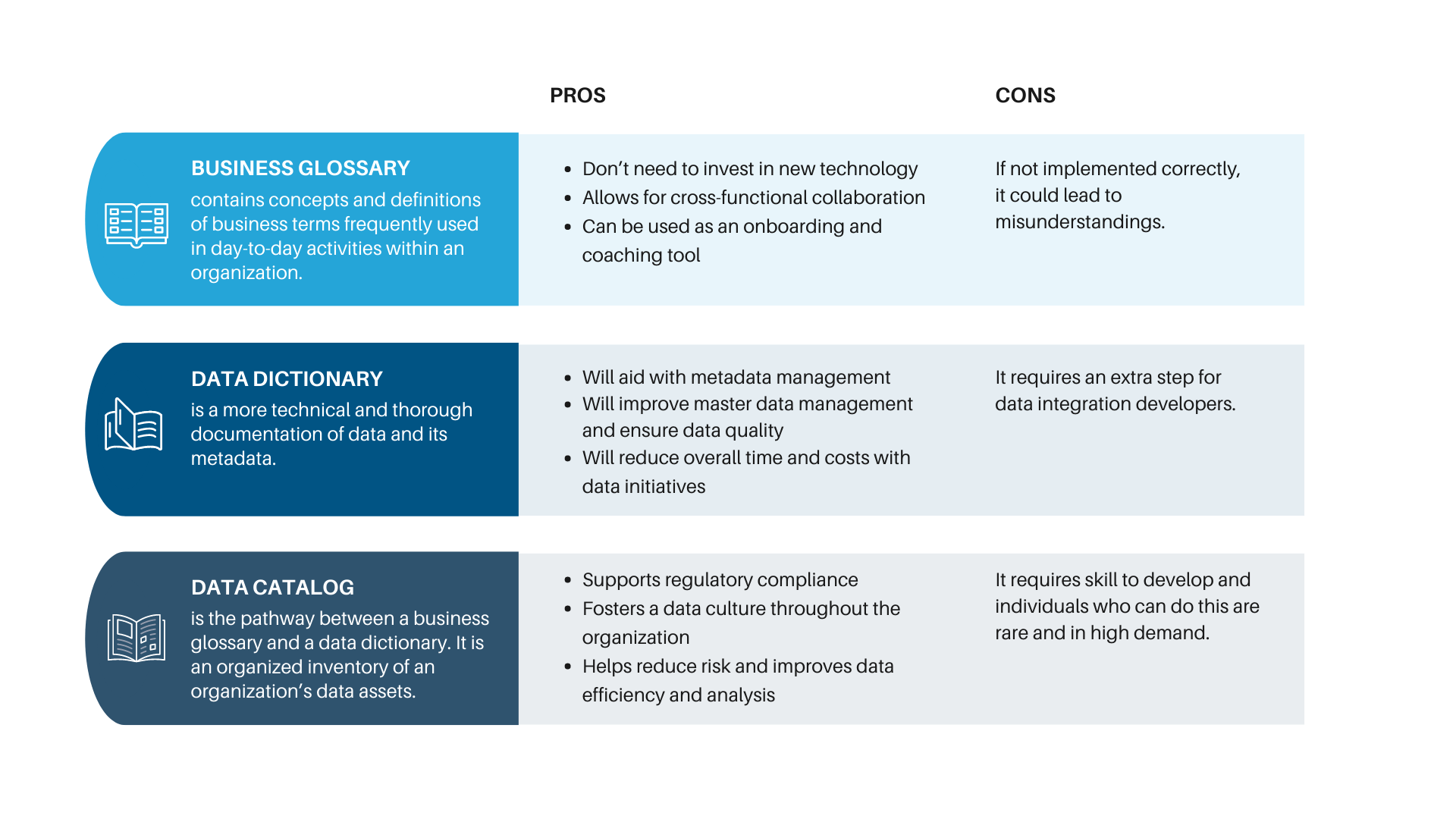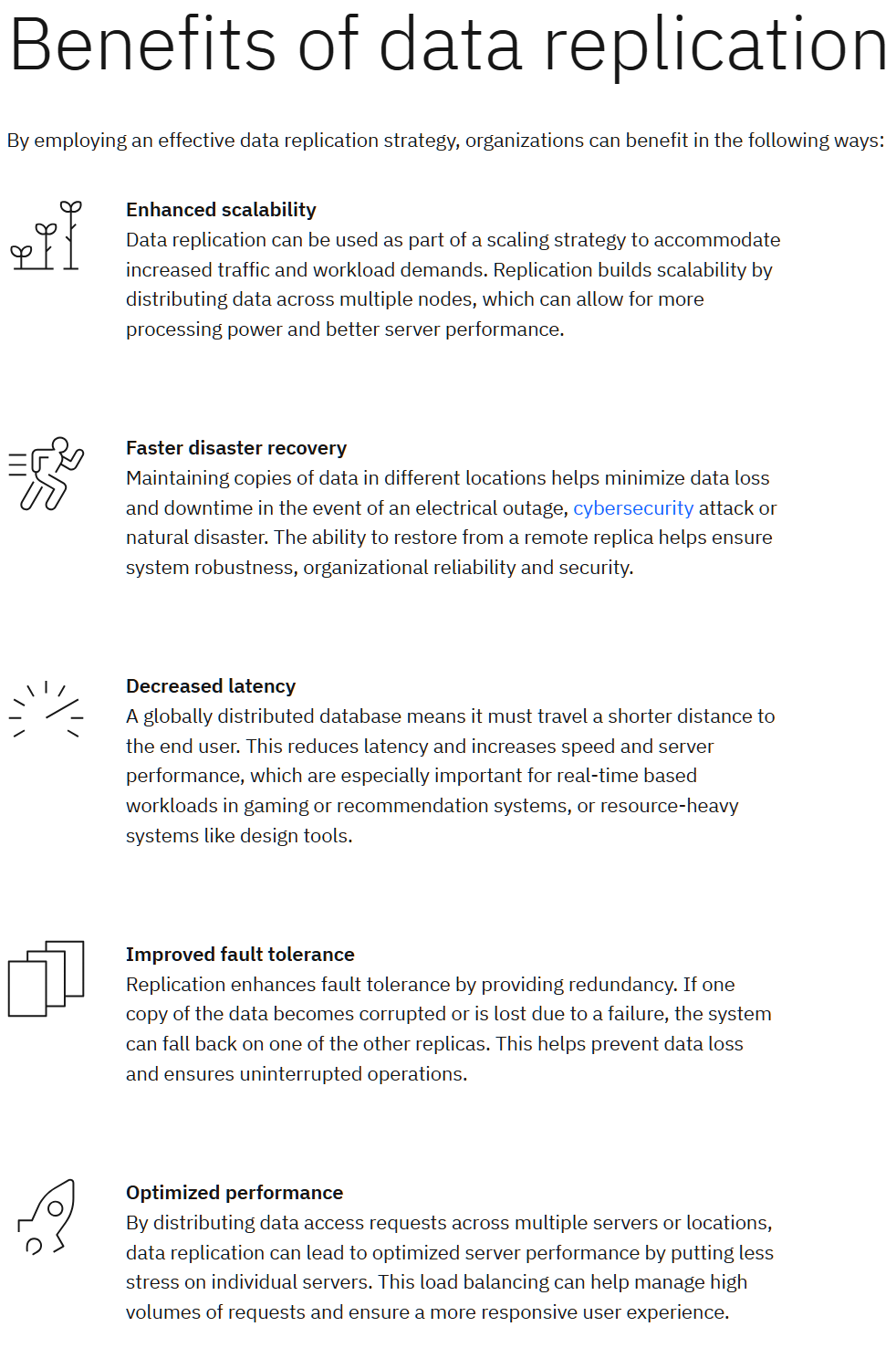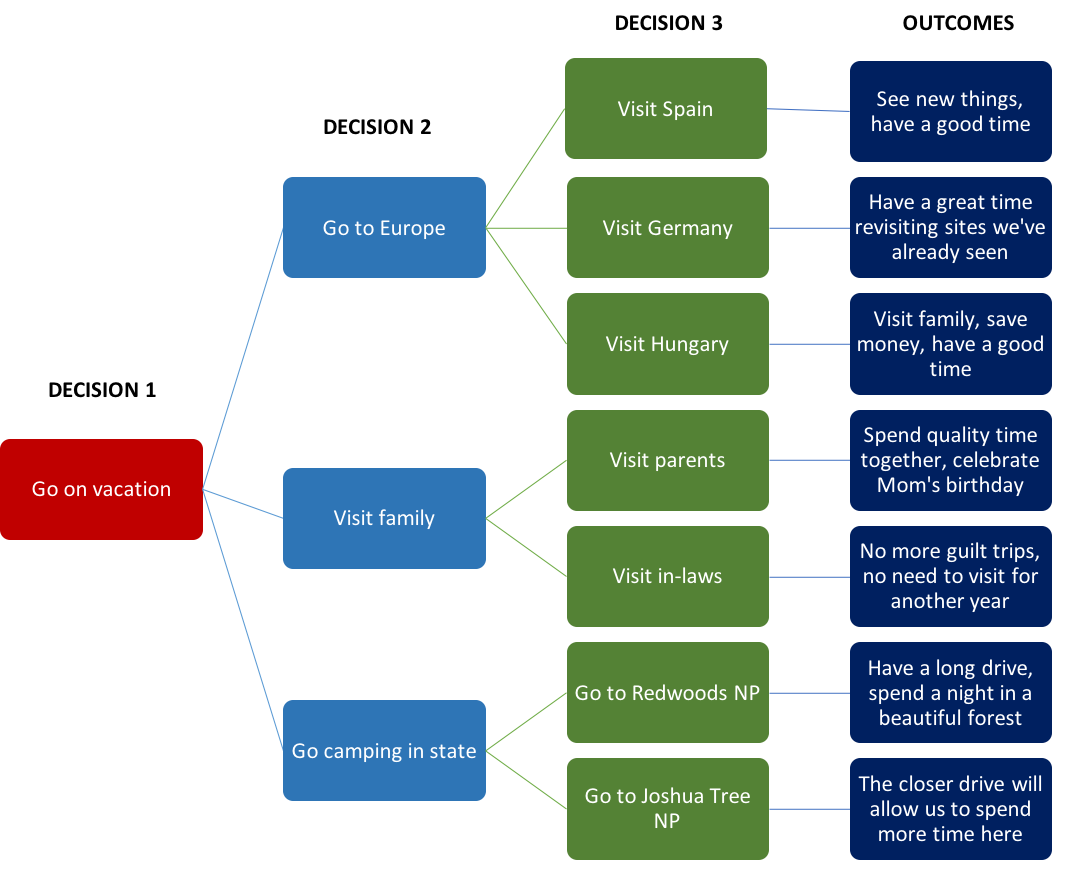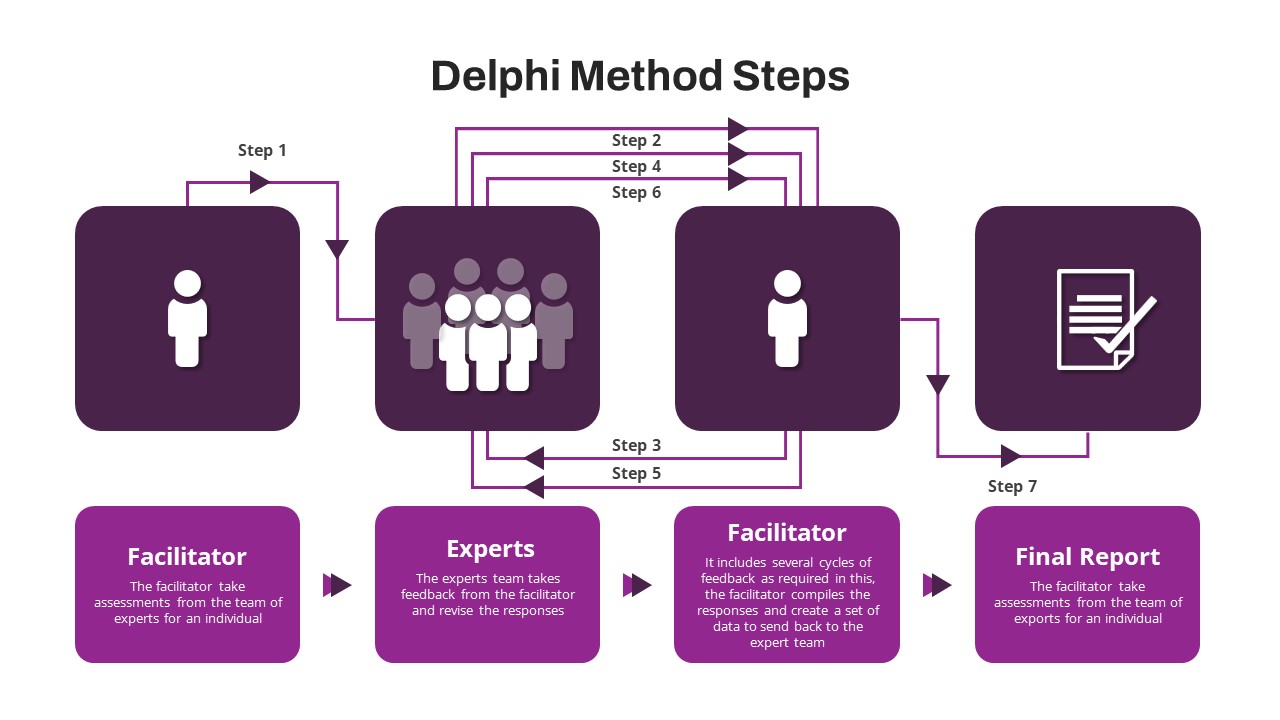Find keyword or terms by letter
Click on a numbered or lettered box below to show list of keywords and terms.
Dark Mode
(Context: General, Software)
Definition
A color scheme that uses light-colored text, icons, and graphical user interface elements on a dark background. It is often discussed in terms of computer user interface design and web design.
Data
(Context: General)
Definition
An arrangement of numbers, characters, and/or images that represent concepts symbolically.
Data refers to raw facts that include numbers, letters and symbols, images and sounds entered into a computer for processing. Data is all the raw, unprocessed facts, concepts or instructions that form the basic materials for transforming or processing into useful and meaningful results. Such facts are of little meaning or significance until they are sorted or put in a more useful form. When stored electronically in files, data can be used directly as input for the information system.
Data Archiving
(Context: Enterprise Architecture, General, Technology Management)
Definition
Generally, refers to long-term storage of data that is no longer in regular use but can be restored if need be.
EA-Solution-Data-Availability-Requirements.pdf (virginia.gov)
Data Breach
(Context: Information Systems Security)
Definition
The unauthorized access and acquisition of unredacted computerized data that compromises the security or confidentiality of personal information. Good faith acquisition of personal information by an employee or agent of an individual or entity for the purposes of the individual or entity that is authorized to view the data is not a breach of the security of the system, provided that the personal information is not used for a purpose other than a lawful purpose of the individual or entity or subject to further unauthorized disclosure.
Data Classification
(Context: General, Information Systems Security)
Definition
A process of categorizing data according to its sensitivity.
Data Communications
(Context: Data Center Facility, General, Hardware)
Definition
Includes the equipment and telecommunications facilities that transmit, receive, and validate COV data between and among computer systems, including the hardware, software, interfaces, and protocols required for the reliable movement of information. As used in this document, Data Communications is included in the definition of government database, herein.
Data communication, including data transmission and data reception, is the transfer of data, transmitted and received over a point-to-point or point-to-multipoint communication channel. Examples of such channels are copper wires, optical fibers, wireless communication using radio spectrum, storage media and computer buses. The data are represented as an electromagnetic signal, such as an electrical voltage, radio wave, microwave, or infrared signal.
Data Custodian
(Context: General, Information Systems Security)
Definition
A data custodian (sometimes a 3rd party supplier) is someone on the IT side of the house who maintains data on systems in accordance with business requirements. An individual or organization in physical or logical possession of data for Data Owners. Data Custodians are responsible for protecting the data in their possession from unauthorized access, alteration, destruction, or usage and for providing and administering general controls, such as back-up and recovery systems. Data Custodians may move data between systems, aggregate the data, and transform the data. If a data custodian is unclear on requirements, they would speak to the data owner. A common misconception is that IT owns the data.
Data Date
(Context: Project Management)
Definition
The date up to or through which the project's reporting system has provided actual status and accomplishments.
PMBOK

Data Dictionary

(Context: Technology Management)
Definition
A centralized repository of information about data such as meaning, relationships to other data, origin, usage and format. A data dictionary includes such items as complete and accurate definitions of entities and attributes, attribute domains, valid values, synonyms or aliases, default values, data type and length, required/not required constraints and other information.
Executive Directive 7: Leveraging the Use of Shared Data and Analytics - Final Report
Data Marshaling
(Context: Enterprise Architecture, Technology Management)
Definition
The conversion of data between platform specific representations and the packaging according to the requirements of a particular network protocol in order to perform the data transport between different nodes.
Commonwealth of Virginia Enterprise Technical Architecture [ETA] Integration Domain Report
Data Owner
(Context: Technology Management)
Definition
An individual, who defines, manages and controls the use of data and ensures compliance with adopted standards within an agency. The Agency Head or designee designates the Agency Data Owner(s) for the functional/subject areas within their jurisdictional control or authority and ensures adequate resources for Agency Data Owner(s) to develop and maintain their respective functional subject areas in support of the Commonwealth's Data Management Program.
COMMONWEALTH OF VIRGINIA Information Technology Resource Management Information Security Standard

Data Replication

(Context: Software)
Definition
The process by which data residing on a physical/virtual server(s) or cloud instance (primary instance) is continuously replicated or copied to a secondary server(s) or cloud instance (standby instance). Replicated data supports high availability, backup, and/or disaster recovery.
EA-Solution-Data-Availability-Requirements.pdf (virginia.gov)
Data Retention
(Context: Software)
Definition
The capability of customers to retain non-current data to meet business requirements. Data retention requirements depend on the content of the data, whether the contents are classified as public records, and agency policies and business requirements.
EA-Solution-Data-Availability-Requirements.pdf (virginia.gov)
Data Safeguarding
(Context: Information Systems Security, Technology Management)
Definition
The application of industry-standard safeguards against the destruction, loss, misuse, unauthorized disclosure, or alteration of the data or confidential information, and such other related safeguards that are set forth in applicable laws, a statement of work, or pursuant to court policies or procedures.
EA-Solution-Data-Availability-Requirements.pdf (virginia.gov)
Data Security
(Context: Information Systems Security)
Definition
Data Security refers to those practices, technologies, and/or services used to apply security appropriately to data.
Data Sensitivity
(Context: Information Systems Security)
Definition
A measurement of adverse affect on COV interests, the conduct of agency programs, and/or the privacy to which individuals are entitled that compromise information systems and data with respect to confidentiality, integrity, and/or availability could cause.
COMMONWEALTH OF VIRGINIA Information Technology Resource Management Information Security Standard
Data Steward
(Context: Technology Management)
Definition
An individual assigned by an agency to represent the agency's interagency data needs and ensure that proposed standards meets those needs. Agency Data Steward(s) work on behalf of their Agency Data Owner(s) and should have a broad understanding of the agency's data, be able to research data usage, be empowered to obtain agreement from Data Owner(s) and have the requisite authority to address data issues for the agency.
Data Storage Media
(Context: Information Systems Security)
Definition
A device used to store data. Examples of data storage media include floppy disks, fixed disks, CD-ROMs, and USB flash drives.
Media Protection Policy Commonwealth Security & Risk Management
Database
(Context: Software)
Definition
A collection of logically related data (and a description of this data), designed to meet the information needs of an organization.
Database Backups
(Context: Software)
Definition
Database backups are backups of structured data created by the database system (e.g. Oracle, SQL, etc.) and written to storage. Database backups can only be recovered by the database system that created the backups.
EA-Solution-Data-Availability-Requirements.pdf (virginia.gov)
Database Management System (DBMS)
(Context: Software)
Definition
Software (associated files and executables) used to support the storage and retrieval of structured data.
EA-Solution-Data-Availability-Requirements.pdf (virginia.gov)
Database Query
(Context: Technology Management)
Definition
A request to access data from a database. Capturing the query allows for playback so that Hunt and IR teams can identify what data was exfiltrated or inserted.
https://www.vita.virginia.gov/media/vitavirginiagov/it-governance/ea/pdf/Event-Log-Management.pdf
Database Record
(Context: Technology Management)
Definition
A set of database fields.
https://www.vita.virginia.gov/media/vitavirginiagov/it-governance/ea/pdf/Event-Log-Management.pdf
Decision Criteria
(Context: Project Management)
Definition
A documented set of factors that are used to examine and compare the costs, risks, and benefits of various IT projects and systems. These decision criteria consist of (1) screening criteria, which are used to identify whether new projects meet initial acceptance requirements and ensure that the project is reviewed at the most appropriate organizational level, and (2) criteria for assessing and ranking all projects. These ranking criteria weigh and compare the relative costs, risks, and benefits of each project against all other projects.
Assessing Risks and Returns: A Guide for Evaluating Federal Agencies' IT Investment Decision-making

Decision Tree Analysis

(Context: Technology Management)
Definition
A diagram that describes a decision under consideration and shows the implications of choosing one or another of the available alternatives. This analysis incorporates probabilities and the costs of each logical path of events.
Decomposing / Decomposition
(Context: Project Management)
Definition
The process of breaking down activities and the work package to a manageable level.
Deep Learning
(Context: Software)
Definition
Deep learning is a type of machine learning that can process more than just text-based data types. Deep learning can process images and requires less human involvement with more accurate results than traditional machine learning. Deep learning techniques leverage a neural network model where data is processed through multiple iterations that learn features of the data. The neural network can then use what it learned to classify new data and determine if an object meets the learned classification criteria. For example, the model learns what a stool looks like, it can recognize the object in a new image.
EA-Solutions-Artificial-Intelligence-Standard.pdf (virginia.gov)
COV ITRM Glossary › A › Artificial Intelligence (AI) | Virginia IT Agency
Deflection
(Context: General)
Definition
The act of transferring all or part of a risk to another party, usually by some form of contract.
Deliverable
(Context: Project Management, Technology Management)
Definition
Any unique and verifiable product, result or capability to perform a service that must be produced to complete a process, phase, or project. Often used more narrowly in reference to an external deliverable, which is a deliverable that is subject to approval by the project sponsor or customer.

Delphi Technique

(Context: Project Management)
Definition
An information gathering technique used as a way to reach a consensus of experts on a subject. Experts on the subject participate in this technique anonymously. A facilitator uses a questionnaire to solicit ideas about the important project points related to the subject. The responses are summarized and are then re-circulated to the experts for further comment. Consensus may be reached in a few rounds of this process. The Delphi technique helps reduce bias in the data and keeps any one person from having undue influence on the outcome.
Design Document
(Context: ITRM perspective)
Definition
A description of an IT system's design that provides the technical specification to a development team for how it should be constructed. A typical Design Document will depict the system and subsystem architecture, logical components, data repository design, processing logic, outputs, runtime environment, and visual and digital interfaces.
Design Documents
(Context: Project Management)
Definition
Technical documents that lay out in detail the anticipated design of the project deliverable.
Design System
(Context: Enterprise Architecture, General, Software)
Definition
A set of interconnected patterns and shared practices coherently organized. Design systems aid in digital product design and development of products such as applications or websites. They may contain, but are not limited to, pattern libraries, design languages, style guides, coded components, brand languages, and documentation.
Desk Centric
(Context: ITRM perspective)
Definition
The Desk Centric role includes End Users who are categorized as performing Administrative, Finance, Contracts, and Human Resources functions. These End Users primarily utilize e-mail, a limited number of applications outside of the normal MS Office suite, web browsing, and spend 80% or more time at the office.
Desktop Productivity Tools Software
(Context: Software)
Definition
Software typically used by business professionals such as word processing, spreadsheets, presentation slides, web browsers, and plug ins. Also includes lesser used software such as personal database software, flowcharting, project management.
Detailed Design Section (DDS)
(Context: Enterprise Architecture)
Definition
Architecture Overview Document (AOD) is split into 3 sections to be completed at different times in the lifecycle of service deployment. Each architecture will include a High-Level Section (HLS), Detailed Design Section (DDS), and an As Built Section (ABS). DDS - Contains the information needed to build or rebuild the system and needs to be completed prior to service going live. It contains not only the system configuration, but also the configurations from any other suppliers that they need to do to bring your system online.
Detailed Project Planning
(Context: Project Management)
Definition
Activities required to complete a detailed project plan for project execution and control as specified in the Commonwealth Project Management Standard and Guideline.
Development
(Context: Project Management)
Definition
The actual work performed to accomplish, effect, or bring about the Information Technology Project.
Development Environment
(Context: Software)
Definition
A non-production environment used to aid the development of software and interfaces. No real or unmasked production data should ever be stored here. Changes made by developers are deployed here so integration and features can be tested. This environment is rapidly updated and contains the most recent version of the application.
DevOps
(Context: Technology Management)
Definition
DevOps is the practice of operations and development engineers participating together in the entire service lifecycle, from design through the development process to production support. DevOps teams use practices to automate processes that historically have been manual and required involvement from multiple groups. DevOps tools are technologies stack which help teams operate and evolve applications faster and independently through automation.
Differential Backup
(Context: Software)
Definition
Uploads any new and updated files after the last full backup. Each consequent differential backup compares datasets only with the last full backup.
EA-Solution-Data-Availability-Requirements.pdf (virginia.gov)
Digital Certificate
(Context: Information Systems Security)
Definition
An electronic document attached to a file that certifies the file is from the organization it claims to be from and has not been modified from the original format.
Digital Signature
(Context: Security)
Definition
A secured signature which works with E-signature and rely on Public Key Infrastructure means it comes with encryption standards. Validation of digital signature is performed by trusted certificate authorities or trust service providers.
EA-Solution-Computer-based-Signature-Standard.pdf (virginia.gov)
Direct Inward Dialing (DID)
(Context: )
Definition
A service of a local phone company (or local exchange carrier) that provides a block of telephone numbers for calling into a company's private branch exchange (PBX) system. Using DID, a company can offer its customers individual phone numbers for each person or workstation within the company without requiring a physical line into the PBX for each possible connection. For example, a company might rent 100 phone numbers from the phone company that could be called over eight physical telephone lines (these are called "trunk lines"). This would allow up to eight ongoing calls at a time; additional inbound calls would get a busy signal until one of the calls completed or be able to leave a voice mail message. The PBX automatically switches a call for a given phone number to the appropriate workstation in the company. A PBX switchboard operator is not involved. A DID system can be used for fax and voice mail as well as for live voice connections. Compared to regular PBX services DID saves the cost of a switchboard operator, calls go through faster, and callers feel they are calling a person rather than a company.
Direct Sequence Spread Spectrum (DSSS)
(Context: )
Definition
A method of providing wireless connectivity as specified in IEEE 802.11b.
Disaster
(Context: )
Definition
An or series of events constituting a disaster under the terms of the or under the Supplier Disaster Recovery Plans.
Disaster Recovery (DR) Services
(Context: )
Definition
The process of following specific advance arrangements and procedures in response to a , resumption of the critical business functions within a predetermined period of time, minimizing the amount of loss, and repairing or replacing the damaged facilities as soon as possible. The Disaster Recovery Services consist of the Disaster Recovery related Services and include support and coordination with the Business Continuity Services.
Disaster Recovery as a Service (DRaaS)
(Context: Information Systems Security, Software, Technology Management)
Definition
A cloud computing service model that allows an organization to back up its data and IT infrastructure in a third-party cloud computing environment and provide all the disaster recovery orchestration, all through a software-as-a-service solution, to regain access and functionality to IT infrastructure after a disaster.
EA-Solution-Data-Availability-Requirements.pdf (virginia.gov)
Disaster Recovery Plan (DRP)
(Context: )
Definition
A set of documented procedures that identify the steps to restore essential business functions on a schedule that supports agency mission requirements. The plan to execute .
Disaster Recovery Planning
(Context: Technology Management)
Definition
The series of processes that focus only upon the recovery processes, principally in response to physical disasters that are contained within Business Continuity Management.
Discount Factor
(Context: Project Management)
Definition
The factor that translates expected benefits or costs in any given future year into present value terms. The discount factor is equal to 1/ (1 + i) t where i is the interest rate and t is the number of years from the date of initiation for the program or policy until the given future year.
CCA
Discount Rate
(Context: Project Management)
Definition
The interest rate used in calculating the present value of expected yearly benefits and costs.
CCA
Discrete Activity
(Context: Project Management)
Definition
A task that has a deliverable, is measurable, and has a definite start and finish. An item on the Work Breakdown Structure would be an example of a discrete activity.
Distributed Component Object Model (DCOM+)
(Context: Software)
Definition
A set of Microsoft protocols that enable software components to communicate directly over a network.
Distributed Computing Environment (DCE)
(Context: Software)
Definition
Includes Remote Procedure Call (RPC), the Cell and Global Directory Services (CDS and GDS), the Security Service, DCE Threads, Distributed Time Service (DTS), and Distributed File Service (DFS).
From Open Computing Group
Document Standard
(Context: Health IT Standard)
Definition
A document that defines the structure of clinical documents. A standard can be defined by an international or national standard-developing organization (SDO), such as Health Level 7 (HL7), or by a particular agency, such as Centers for Disease Control and Prevention (CDC).
Document Type Definition (DTD)
(Context: Software)
Definition
An XML protocol for communicating tagging standards that will be used in an XML communication. The definition of a document type in SGML or XML, consisting of a set of mark-up tags and their interpretation.
XML Protocol (XMLP) Requirements
Domain Name System (DNS)
(Context: Software)
Definition
A general-purpose, distributed, replicated, data query service chiefly used for Internet communications for translating hostnames into IP addresses.
Domain, Enterprise Technical Architecture
(Context: Enterprise Architecture)
Definition
The Enterprise Technical Architecture (ETA) is typically divided into logical groups of related technologies and components, referred to as "domains". The purpose of a Domain Architecture is to provide a combination of domain principles, best practices, reusable methods, products, and configurations that represent "reusable building blocks". Thus, the Domain Architecture provides the technical components within the Enterprise Architecture that enable the business strategies and functions. Note, the Conceptual Architecture serves as the foundation for the Domain Architectures and ensures that they are aligned and compatible with one another.
Demystifying Enterprise Architecture Domains: A Comprehensive Guide
COTS EA Workgroup, "Commonwealth of Virginia Enterprise Architecture – Common Requirements Vision," v1.1, December 5, 2000, p 26
DS3
(Context: )
Definition
A signal with a transmission rate of 44.736 Mbps (672 voice channels) provided over T3.
Duration
(Context: Project Management)
Definition
The total number of work periods (not including holidays or other non-working periods) required to complete a schedule activity or work breakdown structure components. Usually expressed as workdays or workweeks. Sometimes incorrectly equated with elapsed time. Contrast with effort.
PMBOK
Dynamic Analysis Security Testing
(Context: Security, Software)
Definition
A runtime analysis of an application that is live in an environment to scan link, images, line of text and code to identify vulnerabilities.
